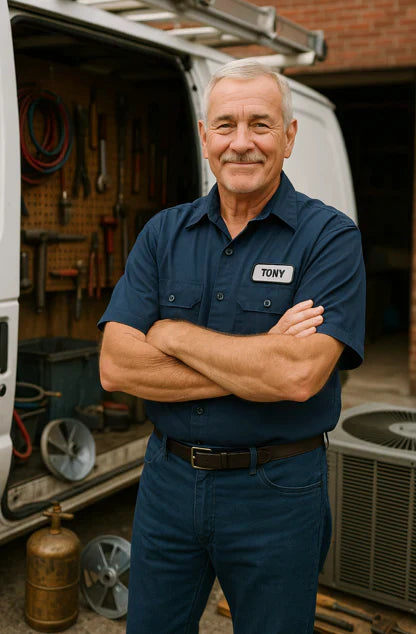⚡️ A New Era of Refrigerants
Hey, Tony here. If you’ve worked in HVAC longer than a cup of coffee, you know refrigerants are changing fast. Gone are the days of R-22 and even R-410A. Now we’re looking at low-GWP alternatives like R-32 — and that means dealing with A2L refrigerants.
R-32 is efficient, has a lower global warming potential, and is fast becoming the industry standard. But here’s the kicker: it’s also mildly flammable.
Don’t panic. I’ve installed dozens of R-32 systems and trained teams on how to do it safely. With the right tools, training, and mindset, A2Ls are no big deal. This guide is your go-to for understanding what A2Ls are, how to work with them safely, and what codes and rules you need to know.
🚫 What Is an A2L Refrigerant, and Why Does It Matter?
Let’s break it down:
-
A2L is an ASHRAE classification for refrigerants that are low-toxicity and mildly flammable.
-
R-32 has an A2L rating and a GWP of 675, compared to 2088 for R-410A.
-
It’s more energy-efficient, requires less refrigerant by weight, and is now allowed in many residential HVAC applications under new building codes.
For a deep dive into the classification system, ASHRAE’s guide to A2L refrigerants is a must-read: ASHRAE Technical Overview on A2L.
So why does this matter? If you’re installing, servicing, or even owning an R-32 system, you need to understand the safety implications. This isn’t like topping off an old R-22 unit. There are new rules—and they matter.
⚠️ Safety First: Fire Hazards and Leak Control
A2Ls aren’t explosive, but they can ignite under the right (or wrong) conditions. Here’s what you need to watch for:
Flammability Facts:
-
R-32's lower flammability limit (LFL) is 14.4% by volume in air.
-
It requires a spark, heat, or flame in a confined space to ignite.
-
It burns with a blue flame, producing HF gas (hydrogen fluoride), which is nasty stuff.
Best Practices:
-
Ventilate workspaces during charging or recovery.
-
Use spark-proof tools and leak detectors rated for A2Ls.
-
Never store cylinders in direct sunlight or enclosed vehicles.
Want to know more? The EPA SNAP Program breaks down the flammability limits: EPA SNAP Refrigerants Guidance.
⚖️ Legal Requirements and Certifications
If you’re an installer or technician, you're on the hook legally for safe handling. The good news is: you’re probably already halfway there.
Here's What You Need:
-
EPA 608 Certification: If you're working with refrigerants, this is required across the board. A2Ls are no exception. You can get certified via online proctoring now through programs like ESCO Institute.
-
State or local fire codes: Some states follow ICC codes with additional rules for refrigerant concentration limits.
-
Proper labeling and documentation: Charge weights, leak tests, and refrigerant logs are not optional.
If you're a homeowner or DIYer, make sure your contractor provides documentation on:
-
Refrigerant type and volume
-
Vacuum test results
-
Safety label placement (it should say "R-32" and "A2L")
🧱 Tools of the Trade: What You Need for A2L Work
Not all tools are built the same. If you're using older R-410A-rated equipment, you may need to upgrade.
Essentials for A2L Refrigerants:
-
Recovery machines with sparkless motors
-
Manifolds and hoses tested for A2L compatibility
-
Ventilation fans for enclosed service areas
-
Combustible gas detectors tuned to R-32
-
Fire extinguishers nearby (Class B recommended)
If you're unsure what tools are rated, ESCO Institute has also published a great overview of tool safety with A2Ls.
🔧 Installation Best Practices for R-32 Systems
Whether you're installing a Goodman R-32 AC system or a full furnace combo, the rules are the same:
Checklist:
-
Maintain clearance space around indoor and outdoor units
-
Seal wall penetrations to prevent refrigerant pooling
-
Always install pressure relief devices and isolation valves
-
Never overcharge—weigh in the refrigerant based on factory specs
-
Add a float switch to detect drain line clogs and prevent overflow
Also important: place your R-32 label somewhere clearly visible on the unit. This keeps future techs and first responders informed.
❓ What Homeowners Need to Know
Homeowners don’t need to memorize refrigerant properties, but they should:
-
Know what refrigerant their system uses (it should be on a visible label)
-
Understand the basics of leak risk and fire safety
-
Avoid doing unauthorized DIY repairs
-
Schedule seasonal maintenance with an R-32 certified technician. Need to find a technician? Browse the ACCA.
🚨 Final Thoughts: Handle R-32 with Confidence
R-32 and other A2L refrigerants aren’t going away—they’re the future of HVAC. They’re greener, more efficient, and being adopted across the U.S. faster than ever. But they require us—techs and homeowners alike—to raise our game.
By getting certified, upgrading your tools, and following installation best practices, you’ll not only stay code-compliant—you’ll keep your clients safe and your installs rock-solid.
Got questions or want to share a tip? Drop them in the comments. And if you’re ready to upgrade to a safe, energy-efficient R-32 system, check out The Furnace Outlet’s R-32 Collection.
Need to know how to install a split system? Click here.
Stay sharp out there.
—Tony 💪🚗







